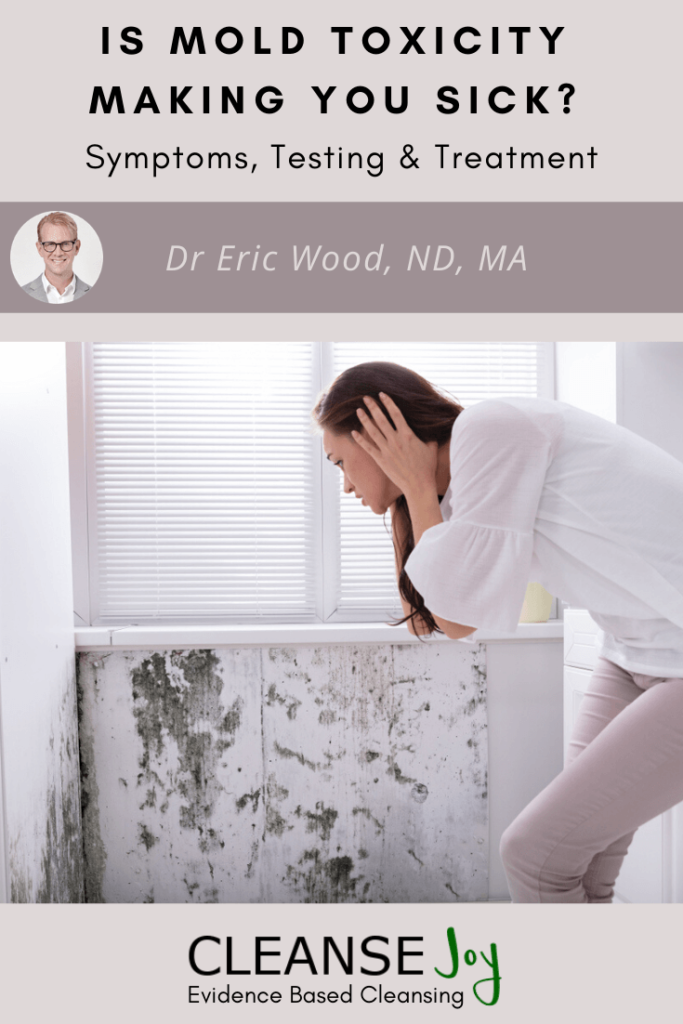 |
Dr Eric Wood, ND, MA Naturopathic Doctor Mold Toxicity Expert |
Reviewed by:
CleanseJoy Editorial Team.
Symptoms | Diagnosis | Treatment | Mold in homes
Did you read one of the many mold toxicity stories, and wondered if it’s possible that your symptoms may be caused by mold exposure?
I can assure you that mold toxicity is real. In fact, mold toxicity is much more common than many people realize. Yet, it doesn’t always get the proper attention by medical professionals who are not specialized in mold related illnesses.
In this article, I will review some of the most commonly asked questions about mold toxicity. We’ll look into health issues that can arise due to mold exposure, how to know if mold is making you sick, treatment considerations and more.
Related posts: How to Detox Your Body from Mold
Water damaged buildings: An unrecognized epidemic
To many individuals’ surprise, it is estimated that close to 50 percent of buildings in the US have water damage. This means there are literally millions of buildings across the country with the potential for harboring and growing mold within their spaces. And this is not just homes or apartment buildings. Think about churches, workplaces, malls, theaters, and other public places people often spend time in every day.
Despite the statistics, most Americans are unaware they are exposed to mold. Mold growth in homes is not always visible or has a musty smell. Moreover, building owners are not always aware of the threats that mold may pose to both themselves as well as any tenants. As a result, they may not take the issue of mold seriously and properly address it.
Symptoms of Mold Toxicity
There are multiple ways mold can affect an individual. It is very important therefore, to know the differences between them, as each may require a different treatment approach.
Mold Allergy
Mold exposure can can cause a mild to severe allergic reaction, and can be tested by an allergist using a standard mold allergy panel.
With mold allergy, there are usually symptoms of an allergic reaction after the exposure such as:
- A runny nose
- Stuffiness and congestion
- Itchy eyes and throat
- Sneezing
Mold allergies are common. However, they are very different from mold toxicity, which typically cause many other symptoms that may affect the entire body.
Mold Toxicity
Some species of mold can induce what we term as ‘mold toxicity’. This is where individuals get sick by the poisons certain types of mold produce, also called mycotoxins.
Some of the most common culprit molds that are known biotoxin producers include Stachybotrys (commonly known as ‘black mold’), Aspergillus, and Penicillium.
Unlike mold allergy that causes respiratory symptoms, mold toxicity may affect the entire body with symptoms such as:
- Fatigue
- “Brain fog”
- Increased urinary frequency
- Muscle twitching
- Anxiety
- Pain
- Sleep issues
- Visual and aural disturbances
- Dizziness
- Nosebleeds
- Sinus problems
- Heightened inflammation
- Digestive issues
Mold Toxicity Risk Factors
Risk factors for mold toxicity include:
- Individuals who have a high toxic burden due to other exposures. (Heavy metals, pesticides, etc.)
- Certain genetic profiles that do not filter mycotoxins as readily
- People over 65 or young children are generally at risk for more severe reactions to toxic mold exposure.
Mold Toxicity Diagnosis & Testing
There are a number of tests that can help identify potential adverse reactions to mold and mold poisoning, and guide the treatment. Some of the common tests may include:
- Mold allergy test. A complete mold allergen panel
- Urine tests for mycotoxins.
- HLA genetic haplotype. about 25 percent of the population is genetically susceptible to mold toxicity. These individuals do not metabolize mycotoxins very effectively and usually experience severe reactions when exposed to mold.
- Indirect markers of mold exposure. Can help determine other imbalances in the body that mold toxicity can cause. As these can get very specific, it is best to see a practitioner specializes in mold toxicity and biotoxin illness.
Just to give you an idea, some of these tests look into antidiuretic hormone, TGF Beta-1, Melanocyte Stimulating Hormone, VEGF, C3a, and others.
Treatment Considerations for Mold Toxicity
Since mold toxicity affect people differently, the treatment may vary from one person to another. Thus, more advanced functional medicine testing that look at toxicity levels, nutritional stores, genetics and other factors more may help to personalize the ideal plan for each patient.
Some of the key components of mold toxicity treatment include:
Stop mold exposure
In order to effectively recover from mold toxicity, its essential to identify and stop the source of mold exposure. You may need to address the mold issue in your home, or avoid being in the building if possible.
Support Detoxification Pathways
There are several ways that can help support the organs and pathways of elimination such as the liver, kidneys, and bowels.
- Glutathione, N-acetyl cysteine (NAC). Play a key role in the body’s ability to detox. Can help to eliminate more mycotoxins.
- Milk thistle. Support normal liver function.
- Burdock root. Support normal kidney function.
- Activated charcoal, charged clay. Bind to mycotoxins in the gut so the body can eliminate them with the stool.
- Physical strategies. Coffee enemas, epsom salt baths, infrared saunas.
- IV therapy can help accelerate treatment progress in certain cases.
Diet for Mold Toxicity
There is no one diet that works for everyone, although some of the things you can do for mold toxicity include:
- Remove inflammatory triggers. May help to quell some of the inflammatory driven symptoms associated with mycotoxin exposure. Main foods to avoid include: refined sugars, gluten, and dairy.
- Eat more cruciferous vegetables. Broccoli , broccoli sprouts and kale can help to naturally support detoxification.
Manage stress
Ongoing biotoxin and mold exposure typically upregulates the stress response. As a result, many individuals develop chronic sleep issues, anxiety, mood swings, emotional lability, and more.
Stress management techniques such as meditation, deep breathing and others can help calm down neurological and endocrine changes.
Personalize the Treatment
Depending on the individual, there can be considerable variation in symptoms and the way the mold exposure affects each person. So, the treatment should carefully be tailored to the individual and consider the whole person.
Testing Mold in Homes
To properly inspect buildings for potential mold, it is always best to work with professionals specialize in mold, who are well educated in the medical and building biology research.
For instance, when a building has had water damage, humidity levels, moisture readings in walls, ceilings, floorings and everywhere must be done. It is essential to screen for surreptitious sources of water infiltration that could fuel mold blooms.
Mold is incredibly stealthy, and can grow under and around caulking, A/C vents and ducts, under flooring, behind walls and showers/tubs, and under leaking roofs. Even faulty dishwashers and washing machines can be affected. Thus, it is not enough that you know you have a mold problem, you must find out where the problem(s) are!
So mold in a building requires much more expertise than standard repair tasks. Just to give you an idea, some of the tests and tools these companies use include:
- Infrared camera. Assess non-obvious potential growth points.
- Test levels of mycotoxins. These account not just spore counts but rather spore counts AND mycotoxin levels. Many companies only test for spores, which will not tell you if your building is harboring substantial levels of mycotoxins. Keep in mind, mycotoxins are the toxins that actually make someone ill.
Mold remediation
The goal of mold remediation is to:
- Fix any structural issues of the dwelling to stop water intrusion and mold growth
- Eliminate and rid the building of mycotoxin and spore residues, which provoke the allergies and toxicity responses.
Also here, mold remediation requires a high level of expertise and specialized equipment and procedures. Ultra-fine vacuuming via an ULPA filter, surface and aerosolized treatment of the entire space, cleaning and treatment of all venting, ductwork, and furnace/AC units and more.
After mold remediation
Post-testing is essential to ensure that mycotoxin and spores counts have dropped to negligible levels. While this is not something many companies do, it is an absolute must. You have to ensure successful remediation. Otherwise all the treatment efforts may be in vain if the space hasn’t been fully remediated. As a result, individuals in that space may continue to get and/or stay ill and affected.
The bottom line: find a highly qualified and well trained mold company to deal with your remediation issues. You do not want to leave this to chance or inexperienced individuals.
In Conclusion
Mold toxicity can severely affect your quality of life and even lead to potentially life-threatening symptoms.
If you or a loved one suspect your symptoms may be related to mold exposure, do not wait. Connect with a doctor specializes in mold illness. An experienced physician can guide you through the many challenges in the diagnosis and treatment, and help you recover and claim back your health.
Read Next
How to Detox Your Body from Mold. A step by step protocol to help your body naturally eliminate mold using diet and supplements.
